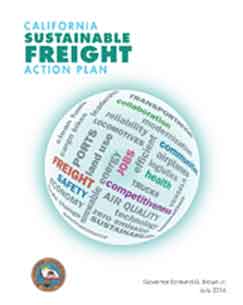After issuing an executive order last year to develop a path for a zero-emissions freight system in California, Governor Jerry Brown this week released sweeping blue-sky plans to propel the state's commercial trucks, ships and cargo trains toward that zero-emissions future.
The big questions: can it work? And if it does, will other states adopt similar measures, perhaps even before the results are in?
The unprecedented effort aims to reshape how cargo is moved around the state, from produce on supermarket shelves to unloading and moving ocean containers at Southern California ports to ecommerce parcel deliveries.
Since the executive order, the state's department of transportation, air-quality board, energy commission and Brown's economic-development have been working to develop what Brown calls the Sustainable Freight Action Plan.
The plan contains a whopping 82 goals. Brown says the plan will deliver a much Greener freight future but in a way that will not hurt the state's competitiveness.
Elements of the plan include:
• Deploying 100,000 trucks, trains and cargo-moving machines powered by cleaner fuels or electricity by 2030, maximize near-zero vehicles by 2020.
• Launching stricter emissions regulations for trains, delivery trucks and vehicles used at airports by 2023 in a state that already boasts the nation's toughest air-quality rules.
• Creating incentive programs, marketing campaigns and even a sustainable-freight "think tank" that encourage the development of Greener technology.
• Making the freight industry more efficient, with a goal of improving efficiency by 25% by 2030. The less time vehicles spend on the road, the less they pollute and the more competitive they become.
• Fostering future economic growth within the freight and goods movement industry.
The plan also identifies opportunities to leverage state freight transport system investments, pinpoints actions to initiate over the next five years to meet goals, and lists possible pilot projects to achieve concrete progress in the near term.
"This Sustainable Freight Action Plan reflects an investment strategy that's right for California: expand economic development, create jobs and protect our environment. The plan doesn't choose between these objectives, but proposes strategies to achieve them all. I look forward to turning this plan into action," said California State Transportation Agency Secretary Brian Kelly.
Next steps for state agencies will include continued work with federal, state, industry, labor, regional, local and environmental and community-based partners to refine and prioritize the strategies and actions outlined in the Action Plan. The state agencies will also create collaborative stakeholder working groups on competitiveness, system efficiency, workforce developments, and regulatory and permitting process improvements.
 Regular California Freight Advisory Committee meetings will continue, and by July 2017, the state agencies will establish work plans for chosen pilot projects. Regular California Freight Advisory Committee meetings will continue, and by July 2017, the state agencies will establish work plans for chosen pilot projects.
Some logistics industry leaders were wary of the plan.
"To spur innovation in zero and near-zero emission technologies, California must make a business case for new investment from the trucking industry, which is already spending $1 billion a year to bring about a more sustainable freight system," Shawn Yadon, CEO of California Trucking Association, said in a statement.
The blueprint lays out a vision of a green California set against the backdrop of a nascent electric-vehicle industry. Until recently, electric vehicles have been limited to consumer cars. But as big rigs, trains and cargo-moving equipment come on line, California could capitalize on the new market.
"The plan is good, but the question is will this make us competitive against other states in getting federal grants," said Hasan Ikhrata, CEO of Southern California Association of Governments.
The ramifications of all this could be far reaching. For example, one regulation calls for requiring so-called "last- mile delivery" companies such as FedEx and UPS to purchase zero-emission fleets by 2020. Whether that would encroach on the prohibition on states from regulating trucking is an open question, though it is possible UPS and FedEx would not fight the rules.
Will all this really deliver a cleaner freight industry? On paper, it would certainly seem to, but the question is at what costs to consumers and logistics firms. States throughout the US will be watching California closely to see how all this plays out.
What do you think of this sweeping Clean Freight program in California? Let us know your thoughts at the Feedback button below.

|